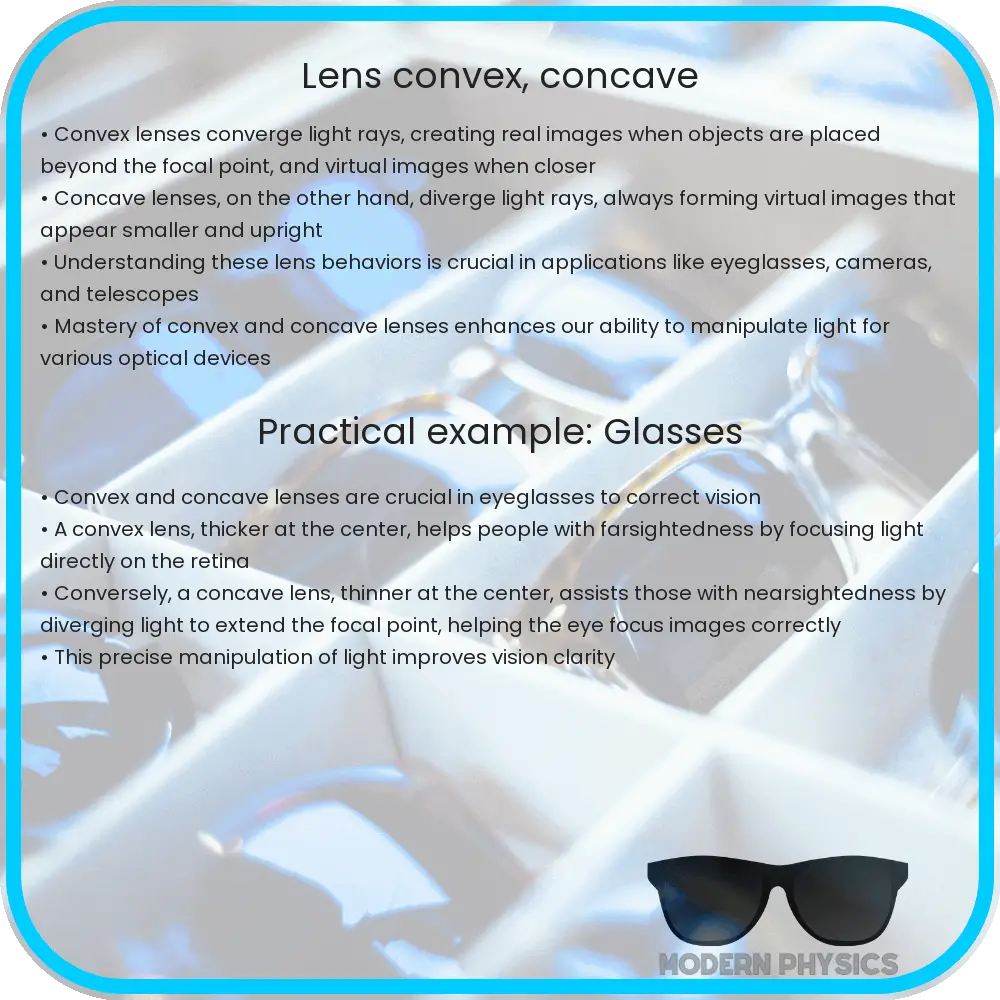Explore the fascinating world of optics with our in-depth look at convex and concave lenses, their applications, and how they shape our vision and technology.

Understanding Convex and Concave Lenses in Optics
Lenses are pivotal in various optical devices, from eyeglasses to cameras, enabling us to see the world with greater clarity and focus. At the heart of lens technology are two primary types: convex and concave lenses, each with unique properties and applications. This article delves into the optics of convex and concave lenses, exploring their characteristics, differences, and how they influence image formation.
Convex Lenses: Bringing the World into Focus
Convex lenses, also known as converging lenses, are thicker at the center than at the edges. This shape allows convex lenses to bend light rays inward toward a focal point. When parallel rays of light pass through a convex lens, they converge on the other side, eventually crossing at the focal point. This property is crucial for magnifying objects and is employed in devices like magnifying glasses, telescopes, and cameras.
- Magnification: Convex lenses can magnify images, making them invaluable for corrective eyewear and scientific instruments.
- Image Formation: Depending on the object’s distance from the lens, the image formed can be real or virtual, inverted or upright.
Concave Lenses: Diverging Rays for Clarity
Concave lenses, or diverging lenses, possess a thinner center compared to their edges. This design causes parallel incoming light rays to spread out or diverge after passing through the lens. Unlike their convex counterparts, concave lenses do not converge light to a focal point but instead, they appear to diverge from a point on the same side of the lens as the light source. Such lenses are essential for correcting short-sightedness (myopia) and for applications requiring the dispersion of light.
- Correction of Myopia: By diverging light rays, concave lenses enable people with myopia to see distant objects more clearly.
- Virtual Images: Concave lenses always produce virtual, upright, and reduced images, making them ideal for certain optical devices.
Both convex and concave lenses play significant roles in optics, each suited for specific purposes based on their unique ability to manipulate light. Understanding these differences is crucial for harnessing their potential in enhancing our vision and the functionality of optical devices.
Understanding the Physics of Convex and Concave Lenses
Lenses are pivotal in the realm of optics, bending light rays to manipulate images for various applications, from eyeglasses to telescopes. Convex and concave lenses, each with their unique shape and functionality, play crucial roles in focusing light and forming images.
Convex Lenses: The Converging Power
Convex lenses, or positive lenses, have a thicker center than edges, curving outward. They converge light rays to a focal point on the lens’s other side. This property is essential in correcting farsightedness and in devices that require image magnification, such as microscopes and telescopes. The focal length of a convex lens, which is the distance from the lens to the focal point, is determined by its curvature and the material’s refractive index.
Concave Lenses: The Diverging Specialists
Concave lenses, conversely, are thinner at the center and thicker at the edges, curving inward. They diverge light rays, spreading them apart as they pass through the lens, which results in a virtual image that appears smaller and closer than the actual object. This diverging effect is particularly useful in treating nearsightedness and in creating optical illusions in peepholes and certain types of artistic installations.
Optics, Clarity, and Focus: The Practical Applications
Both convex and concave lenses have widespread applications in everyday life and scientific instruments. Convex lenses’ ability to converge light makes them indispensable in creating clear, focused images in cameras, projectors, and binoculars. On the other hand, concave lenses are often used in combination with convex lenses to correct optical aberrations and improve image quality in telescopic systems, enhancing clarity and detail.
Conclusion
The science of convex and concave lenses is a cornerstone of optical technology, profoundly impacting how we view and interact with the world. By manipulating light, these lenses allow us to correct vision, explore the cosmos, and capture moments in stunning clarity. Their applications, from medical devices to astronomical telescopes, underscore the critical role of optics in advancing both science and everyday life. Understanding the principles behind these lenses not only unveils the complexities of light and vision but also opens the door to innovation and discovery in countless fields.
Is this conversation helpful so far?
